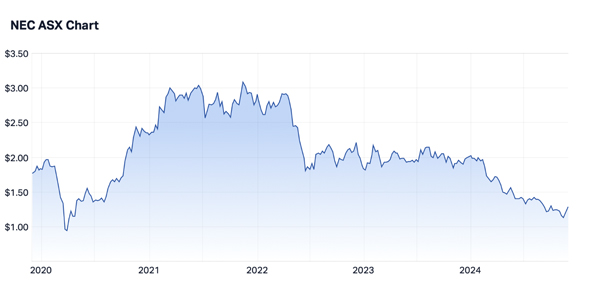‘$10 for a block of cheese!’
‘$20 for a pint? WTF?’
‘No way we’re going to Europe this year.’
All over the country the BBQ talk is the same: the cost of living!
The mortgage belt is getting slugged on their mortgage, insurance, energy, school fees and…anything else you care to name.
We don’t have to look far to see the industry copping the brunt of all this.
It’s the advertising market.
We can see this on the ASX too.
Look at the chart for Seven West Media [ASX:SWM] as one example…
| |
| Source: Market Index |
And here’s Nine Entertainment [ASX:NEC]…
| |
| Source: Market Index |
Granted, these two companies are facing bigger issues besides the current advertising downturn.
Still, broadly we can say that stocks dependent on advertising – and, in turn, consumer spending and confidence – have copped a flogging over the last two years.
Hello, silver lining!
One of my favourite set ups in the share market is when things go – for want of a better expression – from “bad” to “less bad”.
Here’s the thing…
Most people don’t get that the market looks ahead. It’s already priced in yesterday, and today.
This is where the smart investor can step in, take the cheap prices on offer…and position for a cyclical upturn.
At this point, I want to introduce you to someone…
Meet Australia’s “renegade” economist
One of my favourite figures in the Australian blogosphere is economist Cameron Murray.
He’s written two great books (get his latest here…I read it!). Plus he has his Substack too.
Cam publicly took on Australia’s draconian Covid response, putting up with the howling of Australia’s endless bureaucrats, do-gooders and Dictator Dan fans.
In other words, he thinks for himself and is not afraid to speak his mind – our kind of guy. He’s independent.
Most of all, he’s trained to make sense of the endless stream of economic data spewing out day after day.
I asked him: How to make sense of what’s happening right now?
Cam told me that people tend to remember the bad times, and not the good. They also skim over when things work in our favour.
For example, petrol prices averaged $1.50 per litre ten years ago. They’re about $1.75 now – about 2% price growth per year. Not inflationary at all.
The mainstream also reports a lot on how weak our wage growth is, making things look bleaker than they really are.
For most households, they have more income sources than just their paycheques. There are small business profits, dividends, property income and welfare payments.
Wages, on average, are only half of household income.
Cam adds:
‘What about housing rents? Surely these are the WORST EVER!
‘Not at all.
‘In fact, rents paid in Sydney are currently lower in inflation adjusted terms today than any point during the whole 2013-19 period.
‘Yes, rents have spiked a lot in many places in the past two years, but that is BECAUSE household incomes increased rapidly.
‘Not that the rapid income change has stopped, so has rental price growth. Asking rents in Sydney have not risen in nominal terms in the 2024 calendar year.’
What can I say? Thank you, Cam!
Nothing Cam says is controversial. Australia is a very wealthy country.
It’s one reason the RBA is not cutting rates right now. Demand remains robust. It’s why the stock market has gone up all year into all time highs.
Property prices are rising in the smaller states, too.
In other words, in aggregate Australia is getting along under the circumstances, but some people are falling behind. That’s life in a capitalist economy.
Why do we care?
We may have a trigger for the big rotation into the small cap sector
One symptom of investor fear Australia’s lacklustre economy is that the market has herded into the perceived safety of the Top 50, especially the big banks.
Commonwealth Bank [ASX:CBA] is currently on a rich P/E of 25 – with little prospects of strong earnings growth. Some say it’s the most expensive bank in the world. The dividend yield is now the lowest in its history.
Here’s why we care…
The team at Longwave Capital found a pronounced negative correlation between the Australian bank index and the ASX small cap sector.
To put it simply, when banks are outperforming, small caps are lagging. When banks underperform the market, small caps normally shine.
With CBA at an extreme valuation, shrewd investors will likely start seeking better value and upside potential elsewhere. If Cam Murray is right – and I think he is – investors will chase growth again.
As Longwave puts it…
‘Since 2005, in five of the six periods when banks underperformed the ASX 300 by more than 5% over 12 months, small caps outperformed the ASX 300 by 10–20% over the same 12-month period.
‘The one exception was mid-2023 when small caps were still in a COVID hangover bear market and bank underperformance was very short lived.’
Australia’s relative resilience means we can back the small cap sector to keep delivering with confidence.
There’s something else that makes me bullish on stocks for 2025. My colleague James Cooper says we can expect a generational lift in commodity prices.
This could shower Australia in national income…and stock investors with big upside opportunities.
See more on what he has to say here.
Best wishes,
 |
Callum Newman,
Editor, Small-Cap Systems and Australian Small-Cap Investigator



Comments